Eddie Murphy’s 1988 romantic comedy Coming to America was a huge commercial success upon its release, despite unanimous critical distaste for the film. The romance in the story falls flat, the comedy resorts to slapstick humor. Critics bemoaned the film’s mediocre acting, especially Eddie Murphy’s, whose characteristic liveliness was drowned in his own script. (Carlson) It wasn’t until recently, however, that people started talking about the film’s anachronistic and ahistorical portrayal of Africa– which gives the sense that the Africans in the fictional country of Zamunda are nothing more than Europeans dressed in Africanities, speaking sophisticated English and sipping champagne. The eurocentricity of the characters seems at odds with their location: outside of the palace, elephants and rhinos lumber across the background and a loud merchant sells Dashikis (Jacobs). The flaws in Coming to America are evident in its whitewashed portrayal of Africa, but cannot be articulated without assessing the position of women in the film– both African and American.

Prince Akeem is bathed by his servants
The most objectified bodies are those of African women that appear early on in the film, before Eddie Murphy’s character, prince Akeem, leaves Zamunda to find true love outside of arranged marriage. The film uses the objectification and submissiveness of African women as grounds to permit their exploitation– their supposed inferiority legitimizes the male desire to dominate women through the male sexual utopia that is Zamunda. Aside from the queen, the only African woman that speaks more than one line in the film is Akeem’s initial bride-to-be, who is depicted as robotic and mindless— the only thing she says “no” to is Akeem’s insistence that she doesn’t need constantly obey him. Since she has been trained since birth to serve him, and is thus dependent on his existence, she refuses to see that she can exist outside of him. The rest of the African women have few lines, all related to their status as servants. In Zamunda’s generalized perception of Africa, unrelenting roots of colonialism and patriotic nationalism depict what is considered the lack of an obviously superior Western ideology– despite clear whitewashing, the customs of Zamunda are depicted as completely and irrevocably sexist. Inherent in the Africanness of the Zamundians is an extreme dichotomy of masculinity and femininity that churns out legions of uniformly obedient and mindless African women that accept their own exploitation (especially sexual exploitation) eagerly and unwaveringly. Zamunda, and presumably all of Africa, is so good at ingraining the virtue of obedience in women that Akeem feels he must leave the entire continent to have a shot at finding true love with a woman who satisfies his intellect “as well as his loins.”
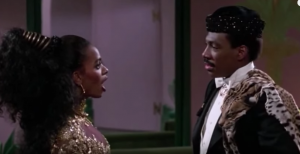
Following Akeem’s order to bark
The dismissal of African women as mentally incapable to justify their exploitation permits their complete objectification, with the effect that the sexual enjoyment Akeem gets from his bathers is depicted not just as as erotic, but expected. The movie justifies this expectation through the characterization of Akeem as singularly righteous– a symbol of progressive, western thought trapped in a backwards society. The most central and thematically well-represented example of this is his reluctance to have an arranged marriage, a major part of the plot that highlights Zamunda’s foreignness. Arranged marriage is a custom widely-regarded by viewers as barbaric and existent wholly outside of modern Western culture, and Akeem’s rejection of it and general dissatisfaction with the culture (that is rigidly obeyed by others around him) aligns him with the Western audience and fuels its perception of his moral integrity.
This conception of Akeem is crucial when he details his qualms with palace life to his father, saying that “it is not just [the rose petals thrown wherever he walks] it is everything. The cooking, the pampering, the dressing, the bathing…” before admitting slyly that he actually “rather enjoy[s] the bathing.” Clearly his qualms with life in the palace stem from a desire for autonomy rather than specific ideological differences with the culture of Zamunda. Not to mention, his desire for autonomy and individualism strengthen the perception of his westernness and masculinity. His admitted enjoyment of the African servant women ultimately permits the viewer to desire or accept their exploitation by trusting Akeem’s moral correctness due to his distinction from the flawed, but erotic traditions of his country.

Akeem’s conversation with his parents
Thus the crucial bathing scene is the most direct depiction of an erotic male utopia in which men are allowed the desire to dominate African women. They are absolved of guilt over this desire by the perception of African women as mindlessly compliant sexual servants and the fact that Akeem (a symbol for western thought, and righteousness) holds the desire himself. With this, the fundamental core of the scene becomes clear– Akeem’s exploitation of African women is acceptable only because their culture (which is inherently inferior to western culture) is one that is less intellectual, thus creating mindless and valueless women who are seen as nothing more than ornamented bodies with which to have sex. This idea of intellectual inferiority, as depicted primarily through Akeem’s arranged almost-wife, draws an uncomfortable connection to a colonialist mentality and the obsession with the “exotic” and “forbidden” African woman’s body (through which the will to dominate a country was, and still is, expressed as sexual violence against local peoples (Nih)).
The extreme irony in this is the film’s premise is a clear attempt to avoid the issue of colonialist thought: Akeem’s riches challenge the trope of poor, starving Africans, and his position of wealth is utilized to mock white people who visit Africa. “Look! Real Americans!” he says as he observes three old men bickering in a barber shop. Putting a black face on a movie whose plot is reverse-colonialist in so many senses, and supporting this character in his rebellion against his homeland’s culture, allows for a comparison of Western and African ideology that affirms the West’s superiority without carrying racial implications. Men are thus allowed to overlook the implications of their own sexual desires and pin them on the ideological inferiority of Africa as a whole, which in turn manifests as the inferiority and justified exploitation of African women.
The film shifts its message about women as Akeem arrives in America– the dominion of men over women here is refined in a way that begrudgingly acknowledges the empowerment of American women, presented in the film through the punishment and stigmatization of female sexuality. After arriving in New York, Akeem and his servant Semmi go to nightclubs to meet women in scenes that function comedically in characterizing the women at the bar as deviant– be it sexually or in some other social regard. From devil worshippers to narcissists, they reveal a fear of female sexuality that renders a woman expressing her sexual desires as cheap or degraded. Semmi, as Akeem’s foil and the prototypical horny guy, smiles at one woman’s statement of interest in a threesome, while Akeem, serious about finding a wife, frowns. This distinction ties into a male perception of female sexuality– it is put on show not just for comedic purposes but also to demonize sexual women, to denote them as unworthy of anything but sex (Gummow). While American women are not mindless like African women, those that are not “clean” and go to clubs do not warrant a man’s respect. Another woman worth noting in this scene downs two shots before proclaiming: “Now that’s the problem! I can’t find a man who can satisfy me. Some guys go an hour, hour and a half, that’s it! A man’s got to put in over time for me to get off.” A reflection of the cinematic trope of the angry black woman, she is the only one in this scene to have short, natural hair, and is clearly meant to be perceived as less traditionally attractive than most of the other women presented in the scene. The importance of this is that her comments can do nothing to hurt the masculinity of the viewer– her presentation as undesirable is exacerbated by her expression of sexuality, and, in addition to being tied to a form of blackness that is deemed undesirable, her short hair and sexual frustration liken her to a man. And as an almost-too-perfect culmination of this idea, the end of this scene features a sexually aggressive trans woman, instantly recognizable as the actor who plays Semmi in drag, detailing, to their disgust, how she’d like to “rip [Akeem and Semmi] apart.”
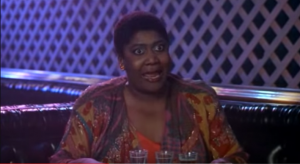
Sexually frustrated woman from the bar scene
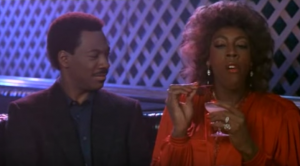
Trans woman (played by the same actor who plays Semmi) from the bar scene
The only primary character in the movie who is shown making sexual advances on men is Patrice, the sister of Akeem’s love interest. She is introduced dancing in her living room as questioning Lisa who she is having sex with when she receives a gift in the mail. Her characterization as a sexual being continues throughout the film– she puts her hand on Akeem’s crotch at a basketball game and has relations with Semmi. Patrice’s sexuality is so central to her character that the film ingrains the audience with a clear answer to her question of why Lisa “gets all the good ones”– that it’s ‘by not being a slut.’ Patrice is also paralleled to the African women at the beginning of the film, especially in comparison to her sister Lisa. She displays her bodiliness as she dances sexually, critically antipodal to Lisa’s intelligence and respectability (think mindfulness) as she reads on the couch. Important to mention too is Patrice’s appearance: she has darker skin and curlier hair than Lisa, and is characterized (stereotypically) as sassy. Similarly to the sexually-frustrated woman portrayed in the club scene, aspects of Patrice’s blackness are shunned and tied to her sexual promiscuity. Thus, the film manages to propagate negative stereotypes about the sexuality of black women, despite having an all black cast, by using stereotypes and afrocentric features to delineate women considered by the audience as more prototypically black as sexually deviant and thus less valuable.
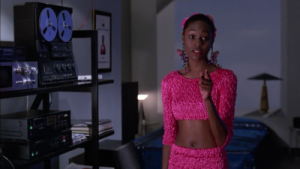
Patrice
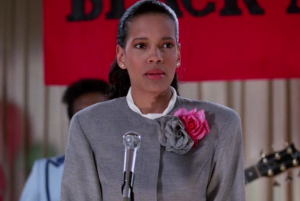
Lisa’s introduction in the film

Bikini Pageant preceding Lisa’s introduction
The film relies on the distinctions between Patrice and Lisa as a way to divide American women and determine whether or not they can be dominated by men. Patrice’s domination is rather clear from what was just discussed: as an impure and invaluable woman, the message is that men will continue to reject her in all ways except sexually– and her own actions are at fault for warranting this treatment. Conversely, Lisa, a “good woman,” is the only woman in the film with any sort of control. She rejects Daryl’s proposal when he and her father try to force her to accept it, and stays with Akeem despite her father’s initial disapproval. After the proposal, Daryl becomes a symbol of machismo– having told Akeem that all women “want a man to take charge, to tell them what to do,” and Akeem, by way of his character differences from Daryl, becomes one resembling a feminist stance (or at the very least, of anti-female domination).
Not only does this late shift in the movie further bury the fetishized African servant woman as inconsequential, it gets the viewers of the movie to applaud the preservation of Akeem’s masculinity via the domination of African women while blending into American society, where such overt domination is culturally inappropriate. His departure from Africa is attributed to the mindlessness of African women, preserving his masculinity and reassuring the male gaze of its morality– which would be lost if the humanity or degraded position of African women was acknowledged. This and the film’s tenacious impression of Akeem’s integrity, which is so pervasive that he is a relatively static character throughout the film, implies that his character alone pits him against Daryl and by association against the control of women. This is why he never has to learn how Americans treat women the way he has to learn how to dress, work, and speak– his being on the virtuous side of this conflict is a given to the audience. So as Akeem experiences America and falls for Lisa, the message of the movie is not that all women are valuable and intelligent, but that most aren’t. A man who accepts and fantasizes about the domination of powerless women and the devaluation of sexual women is nonetheless capable of being considered the “good guy,” provided he doesn’t attempt to dominate a “good woman” like Lisa.
References:
Carlson, Daniel. “Is It Just Me, or Does Every Woman in New York Have a Severe Emotional
Problem?” Pajiba. Disqus, 05 May 2009. Web. 8 Dec. 2016.
Gummow, Jodie. “Unveiling the ‘Madonna-Whore’ Complex.” Alternet. N.p., 9 Sept. 2013. Web.
7 Dec. 2016.
Jacobs, Sean. “Africa on Film: Coming to America.” Africa Is a Country. N.p., 14 Apr. 2015.
Web. 10 Dec. 2016.
Tih, Felix N. “Rape of Africans by Europeans: An Ongoing Colonial Habit.” The Anadolu Post.
Anadolu Agency, 18 Sept. 2015. Web. 7 Dec. 2016.